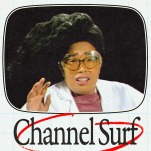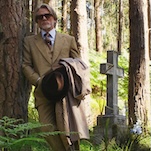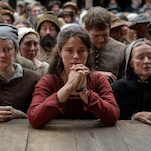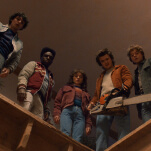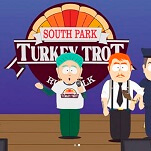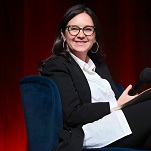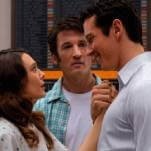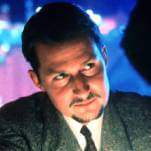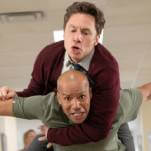Swingtown tried premium-cable steaminess by broadcast-network standards

Swingtown, a dramatic series about three families navigating changing social attitudes and sexual mores in the mid-1970s, ran on CBS for 13 episodes in 2008. By beginning in the Bicentennial summer of 1976, creator Mike Kelley used the brief window of time between the unofficial, spiritual end of the ’60s and the big chill of the ’80s to show how “average” Americans finally absorbed the fallout from the sexual revolution. To watch the series now is to revisit a very specific moment in pop-culture history: Namely, the moment when even CBS—the broadcast network most vulnerable to jokes about how its loyalest of viewers never watched anything else, because they were too crippled by arthritis to change the channel—felt the need to compete with the more daring programming available on premium cable.
The commercial networks initially had a funny, schizoid reaction to the critical accolades and zeitgeist buzz generated by such cable shows as The Sopranos. In 1999 and 2000, newspapers and magazines ran a lot of trend pieces on that show, and no article was complete without a quote from some genius at one of the old-school networks, comparing the actual number of people who watched The Sopranos week-to-week with the number of those who dozed off in front of the latest episode of Diagnosis: Murder or Judging Amy. Their point was that Tony Soprano and family wouldn’t have lasted a month on a “real” network. (Critics would counter that this was exactly the problem with the real networks.)
But at the same time, network brass were loath to concede that the cable upstarts made better TV shows than they did, even if they could console themselves with the idea that fewer people watched them. So the networks began to turn out shows that represented their version of an HBO series—shows like Kingpin, a smart, engaging drug-cartel drama created by David Mills. NBC proudly hyped the show 2003, only to burn off its six completed episodes in little more than two weeks. More recently, the network has lavished its hopes on Hannibal, which NBC executives seem prepared to keep around for as long as they can, no matter how few people watch it. Presumably, they’ve finally figured out that a well-tended cult show can generate more money further down the line, for whoever holds the rights.
One thing that Kingpin and Hannibal had in common—with each other and with other, more misbegotten attempts at envelope-pushing network shows like ABC’s 2003 mob drama Line Of Fire—was that their major line of attack was through scenes of violence, gore, and general amorality. A show that intended to redraw the boundary lines regarding sexual content on TV was a trickier sell, and as if to prove it, Mike Kelley and his co-producer Alan Poul (whose credits included Tales Of The City, My So-Called Life, and Six Feet Under) had previously failed to sell Swingtown to HBO. HBO reportedly felt that it already had its hands full with its own contemporary sexual-relations series, Tell Me That You Love Me and Big Love.
Kelley and Poul were readying their pitch to Showtime when Nina Tassler, president of CBS Entertainment, reached out with an offer to greenlight the series. That meant significantly reshaping the concept, to strip away the planned nudity and graphic sex scenes. Having given the pilot script a quick overhaul, Kelley (who wrote the first couple of episodes) and Poul (who directed them) assembled a terrific cast, which happened to include a number of actors who had already demonstrated their willingness to perform sexually risky material. In commercial-television terms, the big star on the lot was former Melrose Place regular Grant Show as Tom Decker, a commercial airline pilot who has an open marriage with his retired-stewardess wife, Trina (Lana Parrilla). The audience-identification characters are the Deckers’ new neighbors: Bruce Miller (Jack Davenport), a futures trader who’s doing well enough to finally graduate to the upper-middle class and move his family to the prosperous suburbia of Chicago’s North Side. Davenport had starred in the racy British comedy Coupling; Bruce’s wife, Susan, was played by Molly Parker. Before joining the ranks of the HBO All-Stars with her roles in Deadwood and Six Feet Under, Parker proved her mettle in such movies as The Center Of The World, in which she played a stripper/escort, and Kissed, in which the 24-year-old actress risked career suicide by fearlessly throwing herself into the role of a necrophiliac who works in a funeral home.
Miriam Shor, who had appeared in such John Cameron Mitchell projects as the stage musical and film Hedwig And The Angry Inch and the film Shortbus, played Susan’s prudish best friend and former neighbor, Janet Thompson, who feels left behind when the Millers flee their shabby neighborhood for a more luxuriously feathered nest; she feels doubly left behind when her old friends start to shed their old middle-class inhibitions and wind up literally in bed with the Deckers. (Josh Hopkins played Janet’s whipped-dog husband, Roger.) The cast also included Shanna Collins as the Miller’s teenage daughter, who jumps into an affair with her summer-school teacher (Michael Rady), and the magnetic, 18-year-old Britt Robinson, as a neighborhood girl whose mysteriously troubled affect bewitches and bothers the Millers’ son, Bruce, Jr. (Aaron Howles). Everyone calls Howles’ character “B. J.,” presumably because it got a laugh out of someone whose good opinion meant a lot to the producers.
The show debuted on June 5, 2008, and started racking up mixed notices. The pilot is not perfect. It begins with Show, resplendent in his blond hair and mustache, sitting in the cockpit of a jet, looking every bit a golden god in an era when commercial flying was a profession with some glamor to it. (The episode title, “The Pilot,” is a sly joke.) Then the on-the-nose topical references and the leering start. Show informs his passengers that “it’s time to stub out those cigarettes and finish up your cocktails,” and the camera pulls back to show the back of a woman’s head; she’s kneeling in front of him, at about groin level, making grunting noises. Then we see that—Ha! Ha!—she’s scrubbing away at a stain on his shirt.
There were people who heard that CBS was behind a new show about swapping spouses in the suburbs in the ’70s and immediately thought of elderly Studio 54 fixture Disco Sally—and this was just the kind of thing they’d imagined they might be in for. It didn’t help that CBS’ way of boasting of its own newfound hipness was to point out that Liz Phair, 1993’s self-elected blow job queen, was part of the team hired to work on the music. We’ve all got to eat, and the music—which included an opening theme song on which Phair’s familiar voice could be heard urging listeners to “give it up for love”—was fine. But considering that it had been five years since Phair had heedlessly, some say thrillingly, torched what remained of her indie cred with her self-titled bid for the Avril Lavigne audience, this, too, felt like a Disco Sally move.






